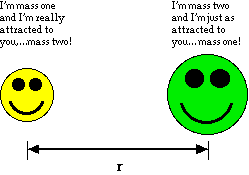Gravity: Another Example of a 1/R2 Law
There are numerous examples in physics where the relationship between
one physical variable and another physical variable follows an inverse
square relationship. The force of gravitational attraction between two
masses behaves in accordance with this relationship.

Two masses at a given distance place equal and opposite forces of
attraction on one
another. The magnitude of this force of attraction is given by:

where G is the universal gravitation constant (6.67 X 10-11
Nm2/kg2), m1 is the mass of the first
object in kilograms, m2 is the mass of the second object in
kilograms, and r is the distance between the centers of the two masses, in
meters.
From this law and the relationship it embodies it can be seen that a
doubling of the separation will cause the force of attraction between the
masses to decrease to a value equal to 1/4 of the original force. A
tripling of the original distance will result in a force which is 1/9 the
original force, and so forth and so on. The graph below represents the
force of gravitational attraction on a 70 kg person as she move from the
surface of the earth towards a distance of 3 x 108 m from the
surface of the earth.

Graph of the force of gravity as a function of distance from Mass
| 